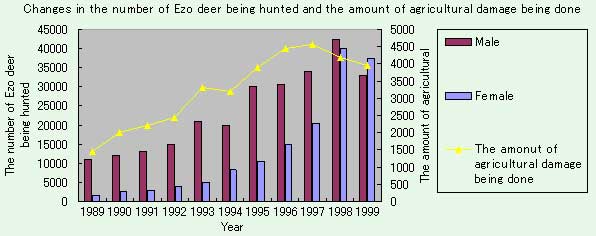| |
Meet Michi: Reference |
| Discussion
Points |
|
| Do you think it
is all right for humans to hunt Ezo deer? Why? Do you think it would be all right to hunt Ezo deer if the meat were put to good use? Do you think the damage to the agriculture and forestry industries would decrease if the Ezo deer were hunted? Is there any way of reducing the damage to the agriculture and forestry industries without hunting Ezo deer? |
|
|
|
|
| The Ezo deer
(a subspecies of Sika deer, Cervus Nippon, which can be found throughout
Japan) populates every region of Hokkaido with its main habitat in the
eastern areas (Tokachi, Kushiro, Nemuro, and Abashiri). Males grow to
be 90-190 cm tall and weigh 50-130 kg, while females grow to be 90-150
cm and 25-80 kg. Its summer coat is a light brown and its winter coat
a dark gray-brown. The Ezo deer remain secluded in the forests during
the day but often go out onto the grassy plains at night to feed. |
|
|
|
|
| At one point,
due to heavy snows and over-hunting in the early Meiji era (1867-1912),
Ezo deer were near to extinction. Institution of protection policies and
the resultant improved conditions of their habitats led to a dramatically
resurgence of the population and range of distribution. Estimated Population of Ezo Deer in Eastern Hokkaido 1993 Approximately 120,000 2000 Approximately 200,000 |
|
|
|
|
| Traffic accidents - Nemuro administrative jurisdiction 235 incidents in fiscal year 1998 - Kushiro administrative jurisdiction 266 incidents in fiscal year 2000 246 incidents in fiscal year 2001 Train accidents - JR Hokkaido, Kushiro branch 282 incidents in 1997 353 incidents in 1998 (all between April and December) - JR Hokkaido, Asahikawa branch 123 incidents in 1996 131 incidents in 1997 |
|
4. Causes of Accidents Involving Ezo Deer |
|
| A little over
40 percent of automobile and train collisions with Ezo deer occur in autumn
and winter. - Ezo deer become more active and mobile during the autumn breeding season (October through November) - They begin migrating in groups to their winter habitat in November and December. - Because the sun rises late and sets early in the autumn, the hours when deer are migrating overlap with the hours when human commuting is most intense. |
|
5. Measures against Accidents Involving Ezo Deer |
|
| Traffic accidents - Establishment of the Shari Eco-road (a deer pass): underpasses designed for use by wildlife. - Maintenance of accident-prevention facilities, such as crossing facilities (deer passes, overpasses, etc.), reflecting boards and fences to prevent deer from coming onto roads, and warning signs to alert drivers. Train accidents - Reflecting boards for the protection of wild animals - Dog and cat chemical repellants |
|
6. Crop and Forestry Damage Caused by Ezo Deer |
|
| Concerning crop
damage, aside from accounting for about half of the damage to pastureland,
Ezo deer continue to ravage sugar beet, wheat, white potato, and paddy
rice crops. In terms of forestry damage, about 96 percent of damaged areas
are tree nurseries, and aside from the damage caused by grazing on the
young, reforested tree saplings and new leaves, Ezo deer also strip the
bark from trees by scraping their antlers along the trunks. In natural
forests, deer grazing adversely affects Japanese elm, Laciniate elm, Ezo-itaya
maple, Japanese yew, and other trees. Eastern region: approximately 2.7 billion yen (fiscal year 2000) Western region: approximately 900 million yen (fiscal year 2000) |
|
7. Causes of Crop and Forestry Damage by Ezo Deer |
|
| Due to a high
fertility rate among female deer over age two and the decreasing mortality
rate among Ezo deer resulting from warmer winters in recent years, the
deer population will increase rapidly, at about 15 to 20 percent annually
if Ezo deer are not hunted. (Meaning that the population will double in
four to five years!) Furthermore, because its diverse diet includes most
varieties of plant life, and its main habitat is in peripheral areas of
the forests, the feeding habits of Ezo deer can easily come in conflict
with the interests of the agriculture and forestry industries. |
|
8. Measures against Agriculture and Forestry Damage Caused by Ezo Deer |
|
| - Building of
electric fences and net fences to keep out deer. - Hunting to thin out the deep population. - Use of chemical repellants in painted or sprayed form to prevent damage to new and young forestry replantings. - Deer feedings. |
|
 |
|
9. Effective Use of Deer Meat |
|
| In order to provide
for the effective use of meat from hunted deer, the Plan for the Management
and Protection of Ezo Deer (Hokkaido, 2002) encourages efforts to
improve facilities for the sanitary butchering and distribution of deer
meat. |
|
Reference: * Eco Network, ed. Hokkaido mori to umi no dobutsutachi [Animals of Hokkaido's Forests and Oceans], Hokkaido Shimbun Sha, 1997. * Doto chiiki Ezo shika hogo kanri keikaku [Plan for the Management and Protection of Ezo Deer in Eastern Hokkaido], Hokkaido, 1998. * Ezo shika hogo kanri keikaku [Plan for the Management and Protection of Ezo Deer], Hokkaido, 2000. * Ezo shika hogo kanri keikaku [Plan for the Management and Protection of Ezo Deer], Hokkaido, 2002 * Ezo Deer Traffic Accident Map (Nemuro administrative jurisdiction, fiscal year 2000), Nemuro, Hokkaido prefectural government branch office * Kushiro, Hokkaido prefectural government branch office website: http://www.kushiro.pref.hokkaido.jp/ * Kushiro Shimbun * JR Hokkaido, Asahikawa branch website: http://www.jrasahi.co.jp/sos.html * Kushiro, Hokkaido prefectural government branch office website: http://www.kushiro.pref.hokkaido.jp/report/reporttop.htm * Hokkaido no kankyo [Environment of Hokkaido], Hokkaido, 2002 |